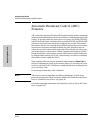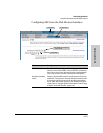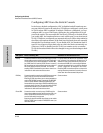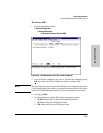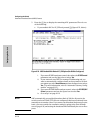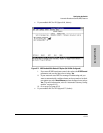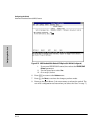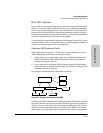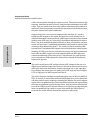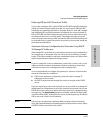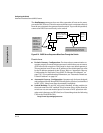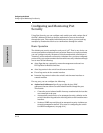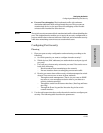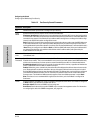
6-114
Configuring the Switch
Automatic Broadcast Control (ABC) Features
Configuring the Switch
with a unicast packet through the switch to host A. The switch monitors this
response, learns the location of host D, and stores this information in its ARP
cache. Thus, the switch now knows the address information for both host A
and host D. Now, hosts A and D can send unicast packets to each other because
they have learned each other’s addresses.
Suppose that host C now wants to communicate with host A. C sends a
broadcast ARP request to the switch. Because the switch already has A’s
address information, it does not flood C’s ARP request out all ports, but instead
sends a proxy ARP reply to C that tells C the address information for host A.
Host C can now send unicast packets directly to host A. From these packets,
host A will learn host C’s addressing information and be able to respond with
unicast packets addressed to host C. The result is reduced network traffic
because host C’s broadcast ARP request was not flooded on the switch’s ports.
Similarly, for IPX networks, the switch learns service and route information
from SAPs and RIPs respectively, and maintains SAP and RIP tables that
contain the addresses of known servers. Using this data, the switch sends
proxy responses to NSQ requests for these servers instead of flooding the
requests on all ports.
Note The switch sends proxy ARP replies to hosts (ARP initiators) that are on a
different port than the target host. However, the switch does not send a proxy
ARP reply when both the initiator and the target host are on the same port.
For example, the switch does not send a proxy ARP reply for host B (figure
6-73) in replying to an ARP request from host A.
The switch does not translate encapsulation types (such as 802.2 to SNAP in
IPX). As a result, if a host client sends an NSQ request for a server, the switch
will always send a proxy response containing the address of a server support-
ing the same encapsulation type. If the switch has not learned of a server using
the same encapsulation type as the host client, then the switch will flood the
host client’s NSQ request to all ports. However, if a local server supporting the
same encapsulation type exists on a port from which the NSQ request is
received, the switch will not forward the request to other ports.



